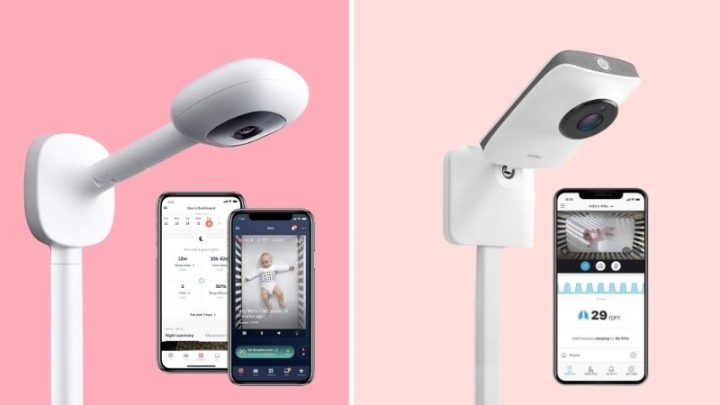Having a baby is one of the most exciting and frightening experiences in every parent’s life. You completely adore your little bundle of joy, but you’re also constantly worried about his safety.
Smart baby monitors have become indispensable for parents around the world because they track and analyze baby’s movements. They can give you peace of mind at any time and help you relax.
The most popular smart baby monitors are Nanit Plus and Miku. They both have great specs, but which one is better?
If we compare Nanit vs Miku, there are several features that should be taken into consideration, such as picture, video and audio quality, installation, and additional equipment.
They both track your baby’s sleeping and breathing patterns by using an HD video camera and microphone and analyze the information within their apps.
These monitors may not be the most budget-friendly, but their price is based on the technology they use.
These models are quite different from low-emission baby monitors, but they do come with lots of benefits.
Smart baby monitors enable you to watch and hear your baby at any time in any place that has Wifi. However, smart monitors also use high-tech features which monitor every movement, breath, number of awakenings, and room conditions.
Wifi baby monitors use sensors and AI technology to allay the fears of anxious parents who feel the need to check on their babies all the time.
There are a lot of smart baby monitors on the market nowadays, but Nanit and Miku are often the top choices of many parents.
If you’re not sure which one suits your needs the best, check out this in-depth review of both products with this Nanit vs Miku comparison. I am sure you’ll be able to make the right decision after reading this article.
Nanit Plus Smart Baby Monitor – In-Depth Review
- ALWAYS BE CONNECTED: Get a crystal clear HD birds eye view of your baby, day or night from anywhere on your iOS, Android, Kindle Fire, or Echo Show device.
- SLEEP TRACKING & GUIDANCE: Nanit gives you your babys sleep stats each morning, plus a timelapse highlight reel of their sleep, so you can rewatch their entire night in seconds.
- MAKING MEMORIES, MADE EASY: With Nanit Memories, your Nanit camera captures your baby’s finest moments automatically right in your app.
- SAFE, SECURE, AND HSA/FSA APPROVED: 256-bit encryption keeps your data safe, and two-factor authentication keeps your account secure.
Prices pulled from the Amazon Product Advertising API on:
Product prices and availability are accurate as of the date/time indicated and are subject to change. Any price and availability information displayed on [relevant Amazon Site(s), as applicable] at the time of purchase will apply to the purchase of this product.
Nanit is one of the most popular brands when it comes to baby monitoring systems. It has been lauded by many parents as one of the best baby monitors on the market which tracks your baby’s sleep by using modern technology.
The company’s story began with a worried parent named Assaf Glazer, who was looking for the best baby monitor to ensure his baby was sleeping safely.
Unfortunately, he was quite disappointed by most baby monitors on the market, either because of poor production or a lack of basic features, but he didn’t give up.
Glazer decided to assemble a team of baby and IT experts in 2014, who created the very first Nanit smart system for baby monitoring.
By using this system, parents could monitor their sleeping baby in real-time and check the baby’s breathing as well.
Ever since then, Nanit’s mission has been to provide the best safety systems for both parents and babies. His company has achieved this goal with the development of the famous Nanit Plus and the newest Nanit Pro system, which has already received rave reviews.
Nanit Plus is still one of the most reliable monitoring systems, even though it was released in 2018. It’s still considered to be one of the best, but it now has a successor, the Nanit Pro.
The latter was released in February 2021 and still has a lot to prove, but those who have tried it did say that it’s an upgraded version of Nanit Plus.
The Plus model was the best-selling smart baby monitor of 2019 and 2020 in the high-tech video monitor category.
Camera
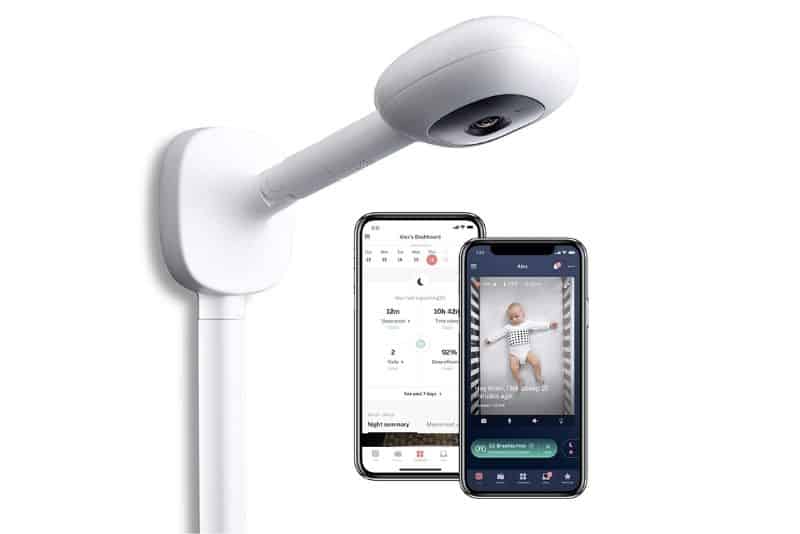
Image via Nanit
Nanit Plus has been a true game-changer in the world of baby monitoring devices. Even though the first, original version did offer very solid results, Nanit Plus has proven there was still a lot of room for improvement.
This model offers excellent video quality, with 1920×920 resolution. However, it has been surpassed by models like iBaby Care M7, Nanit Pro, and others that have Full HD resolution.
If you possess a phone or tablet made after 2017, you’ll have no problems enjoying the full experience of high-quality video streaming.
But, to monitor your baby at any time and anywhere, you need to have a good Wifi connection. This also means you can check your baby or the nanny wherever you are, even when you’re at work or out and about.
You can also share the video with anyone from the family, no matter how far away they are – all they need is a good internet connection.
The camera also possesses a great zoom-in feature, which doesn’t reduce the image quality because of the high-resolution camera.
With this feature, you can see every detail clearly, without blurry images, even if your baby starts to move.
The Nanit Plus camera is also known for its high-quality night vision, which is enabled by 10 infrared LED bulbs.
That’s not all, though. The camera also includes a night light you can turn on via the app. You can’t adjust it, but it doesn’t affect the image quality.
Audio
Full HD video is not the only good feature of Nanit Plus, though. This model includes several audio improvements and has better sound quality than the older version.
The two-way audio communication feature is included in the Plus model now, even though it was seen as a danger before.
The main concern was that someone might hack into the system and communicate with your child without your knowledge.
There’s no need to fear though, as this model offers maximum security for both parents and the baby.
You can talk to your child at any time to soothe him with your voice and calm him down during the day or night, or even speak with anyone who’s in the room with him.
You can enable and disable this feature on your device if you prefer, and customize the user permissions, including the viewer’s access to audio.
This model has an integrated white noise feature and plays nature sounds to your little one, but it has no lullabies, unfortunately. You can even choose how long you want to leave it on: 30 minutes, 60 minutes, or until you turn it off.
These sounds include:
• Wind
• White noise
• Waves
• Birds
Installation
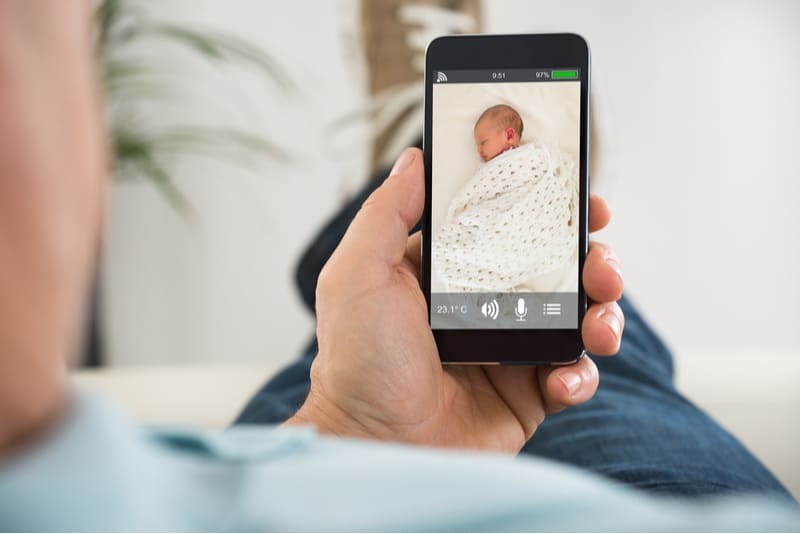
Nanit has a lot of positives, but the installation process isn’t one of them.
You can mount the camera in three different ways to get a bird’s eye view perspective or a direct look at your child.
The main issue is that the camera can’t move in any direction. You’ll have to place the camera directly above the crib or the bassinet if you want to have a full view of your child.
This includes wall drilling and using the wall mount that comes with the product.
Many people don’t find this feature very practical, especially as you have to either always keep the crib in the same location or make another hole in the wall if you want to move it.
One good thing is that the cable comes with a cover, so your baby can’t reach and grab it.
Also, the camera is detachable from the wall mount, so you can take it with you wherever you go or even use other mounts as well.
The multi-stand mount is a small, light stand and a great option for traveling (so you don’t also have to drill holes at other people’s houses).
It’s 6 inches long and faces outward toward the bassinet, crib, or pack ‘n play, etc. This is a very useful feature for trips, but you can’t use Nature Insights sleep quality and recommendation options with it.
The floor stand mount doesn’t come with the basic Nanit Plus set and is regarded as an optional stand. Basically, you’ll have to pay more to get it, but you won’t have another chance to buy it after the initial purchase.
This floor stand is a good choice for people who don’t want to drill the wall and also want the same perspective as with the wall mount.
However, it’s a little bit strange that it comes with only two legs, so you have to keep it near the wall. It would be nice to be able to move it around the room or find different positions for it, but I guess you’ll just have to stick to the wall.
Personally, I prefer the wall stand over the others because of the sleep tracking features. The bird’s eye view enables you to see the whole crib, as Nanit’s camera features a wide-angle lens.
Breathing and sleep tracking
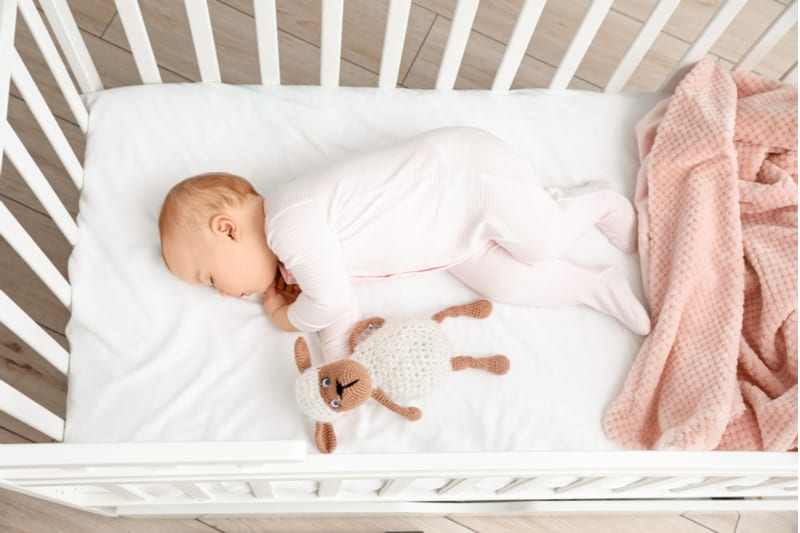
As we discussed earlier, Nanit’s main mission is to keep your baby safe while he’s asleep and provide you with all the information about his sleeping and breathing patterns.
Nanit Plus does an excellent job at sleep tracking, including providing information about the sleep length, quality, and the best position for your little one (where he spends the most time during his sleep).
It doesn’t analyze information to suggest a new bedtime, which might be a slight drawback for some parents who are not yet sure how to prevent a meltdown before bedtime, but it does a lot of other things.
However, if you want to explore your child’s sleep patterns to the fullest and receive useful information, you’ll need the Nanit Insights service.
The good news is that Insights comes for free for the first year, but you’ll have to pay 50 dollars per year after that for each device (if you have multiple Nanit baby monitors for two or more rooms, you’ll have to pay 50 bucks for each of them).
The bad news is that you have to pay for additional storage time as well. The Insights include video and sleep analysis cloud storage for seven days, and if you want more, you’ll have to pay more.
Nanit Insights monitors your baby’s sleep, analyzes it, and provides you with practical advice about your baby’s sleep patterns.
What I love the most about it is that it doesn’t just give you general advice, but customizes it to your child’s sleeping data.
This Nanit model includes Breathing Monitoring, which is a part of Nanit’s Breathing Wear line.
The Breathing Wear Starter Pack, which comes as part of the complete monitoring system, includes a swaddle and a velcro band that is covered with a black shape pattern that helps the camera track breathing motion.
The app enables you to track your little one’s breathing pattern per minute. When your child has his sleeping wear on, the bottom of the screen in the app will pulse green as your baby inhales and exhales.
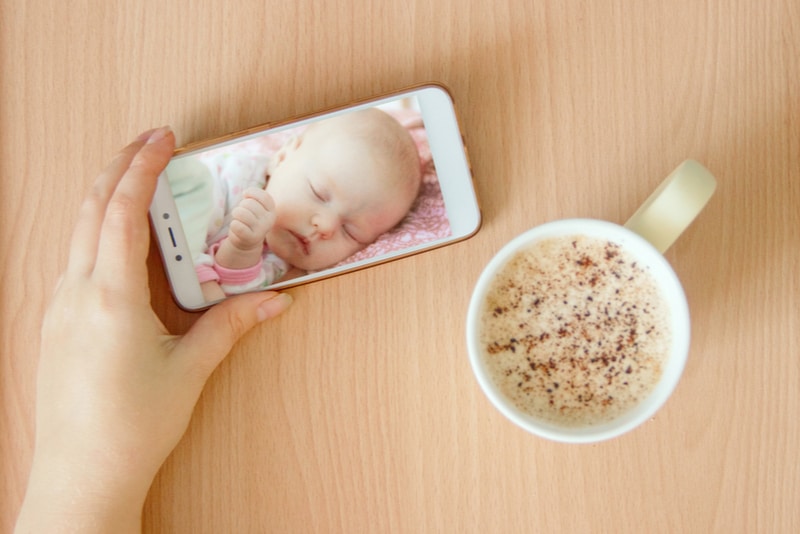
However, there’s one feature that might cause you some trauma, and it’s called the Red Alert. It’s exactly as the name suggests, an alarm that turns on if the camera doesn’t detect breathing for 20 seconds.
The alarm plays on your device and the camera itself, and it’ll definitely wake the baby (unless he can somehow magically sleep through it).
But, the whole system works so well that you won’t hear the Red Alert unless it’s a real emergency (I hope you never hear it).
If your baby has stopped wearing swaddles, doesn’t like velcro bands, or doesn’t keep calm enough during the night, you can always get other pieces of clothing like pajamas or sleeping bags.
They come in all sizes, so don’t worry if your baby is bigger than average.
The one thing I’m crazy about when it comes to Nanit’s Breathing Wear is that it doesn’t include any electronics, which makes it much more affordable and safe.
This comes as a great alternative for electronic baby monitors like the Owlet Smart Sock, which is great of course, but very pricey for just a sock with a band and sensor.
Owlet is great and gives you peace of mind as it has a pulse oximeter, but it only works if it’s in the base station’s Bluetooth range.
Plus, when it comes to Nanit and Owlet, Nanit is more concerned with the overall sleeping and breathing pattern than Owlet, and works on more devices, while Owlet works only on iOS.
Parent Unit
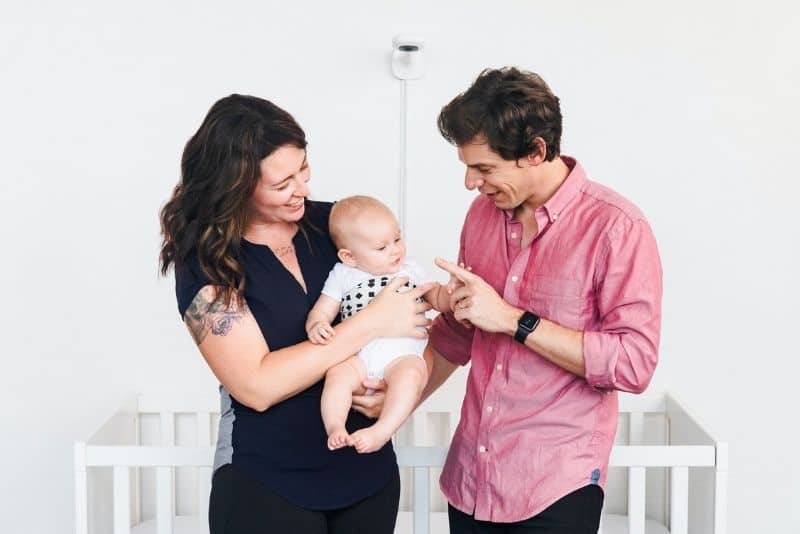
Nanit has gone another step ahead of most baby monitors by excluding a dedicated parent unit and using a BYOD (bring your own device) feature.
Instead of a high-quality screen with speakers that would cost a fortune, Nanit has come up with a great app that works on both iOs and Android devices.
The app is free to download and acts as the control center for the baby monitor. A great feature is that it works perfectly in the background, so even when you’re using other apps on your phone, you can still hear your little one.
As you can imagine, it drains the battery, so always keep your charger close by.
The parent unit includes a lot of useful features that can’t be found with traditional baby monitors.
The first one is the monitor’s HD feed, which is live 24/7 and continues streaming live feed to your phone even when you have Wifi connectivity problems, including outage (they have to be connected to the same network, though).
You can turn on the light, go full screen, or take a snapshot at any time. There are a few other additional features as well, including temperature and humidity monitors.
The app also includes the activity component, which shows you a summary of your baby’s activity in the crib. You can go back several days with the standard package, or up to a year with the Insights packages.
The dashboard shows you all sleep stats, including the time your baby went to sleep, the time he spent in the crib overall, how many times your baby was visited, total time of sleeping, sleep efficiency (the time he spent asleep divided by the overall time in the crib), and an overall sleeping score.
Almost every app has a settings function where you can make modifications, customizations, and set up permissions.
Last, but not least, is the inbox feature, which sends you tips and tricks for sleeping based on your baby’s data.
Miku Smart Baby Monitor – In-Depth Review
- TRACK BREATHING & SLEEP WITH NO WIRES OR WEARABLES: Miku Smart Baby Monitor works with your smartphone to track breathing, movement, sleep patterns and nursery conditions such as temperature and humidity.
- HD VIDEO & SOUND: Share and download unlimited HD video and photos from your smartphone.
- HSA/FSA approved, no hidden subscription fees, room temperature and humidity sensors, night vision, two-way audio, no wearables required, no batteries required, quick and easy installation. custom sleep sounds and lullabies.
Prices pulled from the Amazon Product Advertising API on:
Product prices and availability are accurate as of the date/time indicated and are subject to change. Any price and availability information displayed on [relevant Amazon Site(s), as applicable] at the time of purchase will apply to the purchase of this product.
Parents know best! This phrase has been proven true once again by two great devices developed by parents who were unsatisfied with the existing monitoring systems on the market.
Miku’s CEO and founder, Eric White, never even dreamed of developing this kind of system until he had his first child.
Disappointed by monitors that only showed black and white spots on the screen, White used his knowledge of electrical engineering to make the very first Miku prototype.
Miku has come a long way since then, and become one of the best monitoring devices for babies.
This model was released in 2019 and is still one of the best-selling video baby monitors on the market. A Qualcomm processor and embedded Crypto Chip are the main features of this baby monitor.
The processor serves as the main head of the monitor, detecting and analyzing the baby’s movements, breathing, and other sounds. It keeps the device running when the Wifi connection is lost as well.
The Miku monitor has 256-bit encryption and a tamper-proof Crypto Chip that keeps all your baby’s sleeping data safe. This chip is unique to Miku and makes it stand out from other Wifi baby monitors when it comes to security.
Miku can track your baby’s movements, sleeping, and breathing patterns without any wearables or wires.
The Miku has a parent unit (Miku app) and a child unit (camera, microphone, and speakers), just like the Nanit model.
Camera
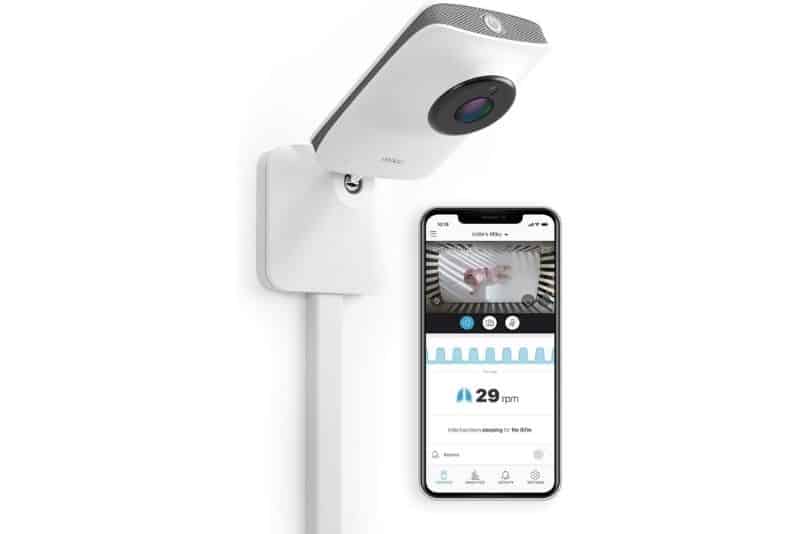
Image via Miku
The picture quality of the Miku monitor is excellent as it captures 720 HD video and possesses a 130-degree field of view.
This model requires a bird’s-eye view for full functionality, but it doesn’t have to be attached to a wall if it can be at least six feet away or out of the baby’s reach.
However, I would still strongly recommend wall mounting for optimal performance.
The camera also has a night vision mode that is supported with infrared LED bulbs, so you can see any movements your little one makes during the night quite clearly.
Miku uses SensorFusion technology in camera to trace your baby’s critical health metrics, including breathing, audio, motion sensing, and conditions in the nursery.
Essentially, the camera can monitor breathing during the live stream, but it can’t measure heart rate or oxygen levels like Owlet, for example.
The video can be shared with other caretakers or family members, but they’ll have to enter the OTP (one-time passcode) in order to gain access to the live stream.
The Miku smart baby monitor doesn’t have an infant night light, which is not necessary but is a nice addition for parents.
Audio
Camera quality may not be at the same level as some other high-end baby monitors, but that’s definitely not a deal-breaker as it’s more important to hear your baby than to see him during his sleep.
Miku’s audio system is great, maybe even a little bit too great, with the dual Ole Wolff speakers that may sound like an awesome feature for audio aficionados, but isn’t really necessary for regular use.
Miku’s baby monitor also has a two-way communication system so you can speak to your baby and listen to her at the same time.
However, this feature could be one of its biggest negatives. The two-way system has a 15-second timer, which means you’ll have to keep turning it on if you want to sing lullabies or soothe your baby back to sleep with a bedtime story.
It can be bothersome but isn’t the worst thing in the world.
Just like the Nanit model, Miku has several white noise options, but some of them do sound quite funny like they come from sci-fi movies.
Of course, there’s “regular” white noise as well.
Installation
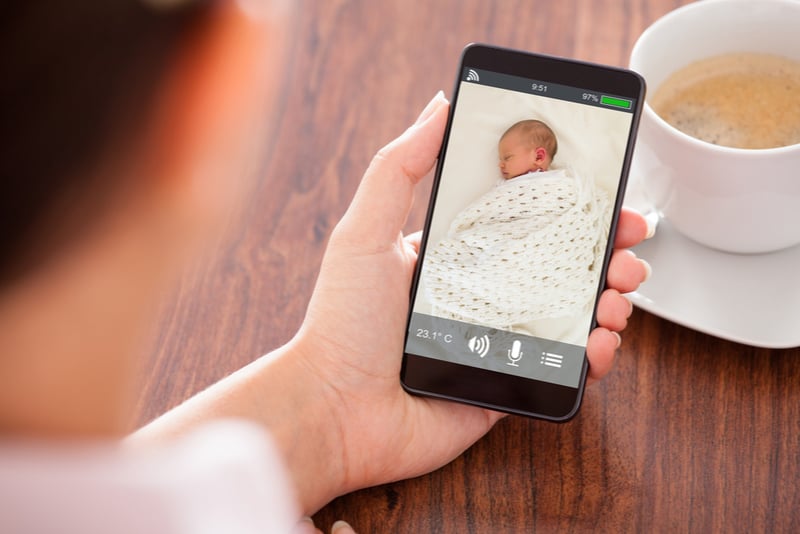
The Miku comes with a camera that can stand on its own or be mounted to a wall (which is recommended by the manufacturer).
Setup is actually quite easy, especially for drywall panels, which only require drywall anchors and screws, which are included with the kit.
However, if your walls are made of brick, plaster, concrete, or other materials, you’ll have to drill the wall or buy an additional floor stand.
The product also comes with cable covers, a mounting plate, and a screwdriver, so you have everything you need for the installment in the box.
Be careful about how you position the camera if you do decide to mount it to the wall, as it doesn’t have a pinch to zoom feature, so you might have to reposition it to get accurate information.
Breathing and sleep tracking
The Miku keeps it simple – no wires, wearables, or electronic devices on your baby. The camera does all the work with its SensorFusion technology, which keeps track of your baby’s breathing, movements, and sound with special sensors.
The device uses radio waves that detect all types of motion in the nursery and is sensitive enough to recognize every breath your baby takes while he is asleep.
These sensors can also measure room temperature and humidity, but we’ll discuss that in more detail in the next section.
Parent Unit
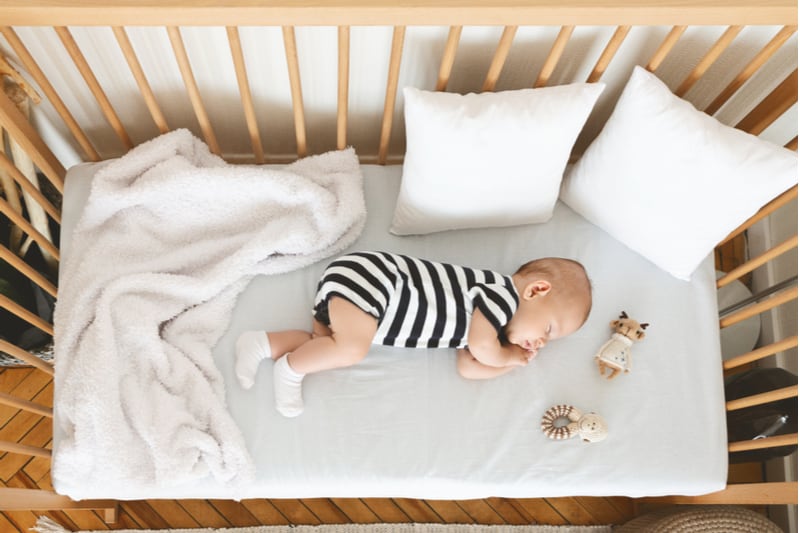
Miku’s parent unit is BYOD as well and works well with Apple products like the iPhone, as well as on Androids. However, it’s not optimized for laptops and tablets, even though some features can work on these devices.
The Miku app enables you, and the caretakers you authorize, to watch a live stream of your baby and track his actions. Every user has to download the app and enter the OTP you provide them.
The app itself is completely free, which is great, but the app itself can be a bit overwhelming and disorganized.
The analytics section on the app provides you with lots of recordings the app thinks are important, but you can’t sort it on your own or customize it to fit your needs.
You will receive information about:
• Breathing pattern
• Sleeping pattern
• Movement
• Activity
• Temperature level
• Sound
It also includes an HD live video stream screen, with the name of the baby monitor at the top middle of the screen and the activity below.
If you enable non-movement events, you’ll receive alarms if there is no detected movement.
You should never keep your phone in “Do Not Disturb” or airplane mode if you want to receive alerts and notifications.
Also, you need to enable permissions and notifications from the app and customize which notifications you want to receive, and which you want to block, in the settings.
This includes the background audio, which lets you hear your little one even when you’re browsing through other apps on your phone.
Settings allow you to check the Wifi signal strength as well as customize all features, but there are no motion-sensitivity adjustments like in some other models.
Nanit vs Owlet vs Miku
The Owlet smart baby monitor is very popular among parents who already own the Owlet Smart Sock.
It’s not expensive and is a great addition that connects to the Smart Sock app, so you can check your baby’s movements as well.
There are no alerts, but the camera is 1080p HD, which makes it better than Nanit or Miku.
However, if you don’t own the Owlet Smart Sock, it won’t be as useful as either of the two mentioned above.
I’d say Owlet is quite pricey and impractical as you have to buy a Smart Sock and a camera separately, and connect both to the same app.
RELATED: Snuza Vs Owlet: Which Is The Better Baby Monitor?
Other Baby Monitors To Consider
1. Cubo Ai Plus
- PEDIATRICIAN CREATED BABY SAFETY SYSTEM: Covered Face & Rollover Alert that uses A.I. to detect if your baby’s mouth and nose are covered or is face down.
- CREATED BY PARENTS FOR BABIES: 1080p HD Video Stream, Crystal Clear Night Vision, Cry Detection, Two-Way Audio, Auto Photo Capture, Temp. & Humidity alert. No Blinking Red Light, In-built Night Light & lullabies.
- Sleep Analytics
- WIFI BABY MONITOR for 0-5 years+
- Check in anywh
Prices pulled from the Amazon Product Advertising API on:
Product prices and availability are accurate as of the date/time indicated and are subject to change. Any price and availability information displayed on [relevant Amazon Site(s), as applicable] at the time of purchase will apply to the purchase of this product.
Cubo Ai Plus is a great video baby monitor that includes sleeping analysis and 18-hour video playback, which gets overwritten with new video materials.
It includes:
• Cry detection
• Temperature and humidity meter
• Night light
• 1080p HD video
• Two-Way Communication
• Night vision
• Lullabies
• Face-down detection
The last one is a great feature and my personal favorite that lots of high-end monitors don’t have.
If your baby rolls over onto his face and covers his mouth and nose, the monitor will alert you immediately. This is a great way to prevent SIDS and choking.
It also includes 256-bit encryption for safety, and you can add up to seven users who can watch your baby and track his sleep.
It doesn’t require any tools to install with its three-way setup and includes: a crib stand (just like that thing that hangs over your baby’s crib), a floor stand, and a mobile stand which is suitable for traveling.
It’s not so pricey, but it does lack some other useful features as well. Overall, it’s a great budget gadget for your baby’s safety.
2. Motorola Halo+
- MONITOR FROM ANYWHERE - Our video infant monitor allows you to check on your little one, whether youre at work or just in the kitchen.
- CRISP & CLEAR DISPLAY - View a real-time video feed of your little ones room on the parent units 4.3 color screen.
- STAY ON TOP OF BABYS HEALTH - The Hubble Baby Smart Sleep Assistant keeps track of your babys hours of sleep, as well as the number of feeding times, diaper changes, and pumping sessions.
- MAKE BABY FEEL SECURE - Did your baby wake up on the wrong side of the crib? This monitor can function as an intercom, thanks to 2-way speakers. Calm your baby with your voice wherever you may be.
Prices pulled from the Amazon Product Advertising API on:
Product prices and availability are accurate as of the date/time indicated and are subject to change. Any price and availability information displayed on [relevant Amazon Site(s), as applicable] at the time of purchase will apply to the purchase of this product.
This baby monitor is really smart, and perfect for parents who are not big fans of drilling and tools. It doesn’t require any wall setup and all you need to do is attach it to the crib.
This can be considered a negative as well. When the baby grows older, he will be able to reach up and grab the camera, which may cause significant problems.
However, it does include two ways of monitoring your baby, an in-home monitor with a screen and speakers, powered by Hubble, or an app on your phone which lets you track your baby’s sleeping pattern, feeding time, and even diaper changes.
It provides a night light as well, but when it comes to the white noise it’s definitely an upgrade from Nanit and Miku. Motorola includes bedtime stories, lullabies, and other sounds that will help your baby fall asleep easily and peacefully.
This smart baby monitor also includes a light show projector, so it can be a great alternative to pacifiers too!
You can connect to Alexa and Google Assistant, which is a great addition but is not really necessary.
The camera is detachable, so you can use it in other parts of the room as well.
Nanit Plus vs Miku
Both are great Wifi baby monitors and game-changers in their own domain. It’s not easy to choose between the two, but after this in-depth review, I have made my call.
Security: Miku
Nanit and Miku both have 256-bit encryption, but Miku has added the Crypto Chip which erases all data in case of any unauthorized use.
Miku uses military-grade security and it’s really difficult to beat that.
Camera: Nanit
When it comes to picture quality, the Nanit vs Miku match is over before it even begins.
Even though Miku does have a high definition camera in HD resolution, 720p is always less than 920p.
Nanit also offers a better night vision feature with clearer video, even though both have infrared LED bulbs and Nanit has a night light at the top of the camera, which is facing upward and you can turn on when you enter the room.
Nanit has the zoom-in option as well, which was promised by Miku but hasn’t been delivered yet.
Audio: Miku
The winner between Nanit vs Miku is clear here – Miku is the winner by a landslide, with the exceptionally strong sound quality provided by dual Ole Wolff speakers.
I’m still not convinced that this feature is really necessary. I mean, it’s nice that your baby has some good quality speakers and clear sound, but most other baby monitors have decent sound as well.
Two-way communication system: Nanit
I had to separate this from the audio because Nanit takes the win for this one.
Miku’s great drawback is the 15-second timer for parents and caretakers, so you’ll have to press buttons for a long time if you want to tell a story to your little one or sing him a lullaby before sleep.
Nanit lets you talk as much as you want, and your baby will feel like you are right there in the nursery with them as you talk without any interruptions.
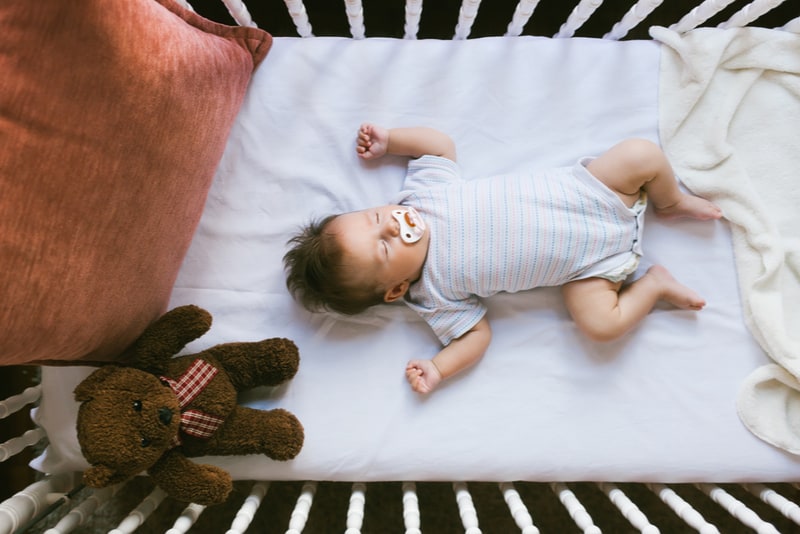
White Noise: Nanit
I almost wrote neither, as they could both use some improvements, but as I’m comparing the two in all other fields, I’ll go with Nanit.
Miku’s white noise sounds are a bit over the top for me, but I’m not a huge sci-fi fan. If you are, or you want your baby to become one, Miku will be the perfect choice for you.
Installation: Miku
Some might say I’m wrong, and I won’t argue with them, but for me, Miku is a lot easier to install.
Having more parts available doesn’t make something better, and I do appreciate that Nanit has three different stands, but Miku has them as well.
Miku can stand on its own, be mounted to a wall, or be set on a floor stand that enables the bird’s-eye view required for optimal performance of both baby monitors, just like the Nanit Plus model.
One more thing I found to be a bit strange with Nanit, is that you can only buy the floor stand with the initial purchase, so make sure you don’t change your mind about it later.
Breathing and sleep tracking: Miku
This one was really difficult for me. My first personal choice would be Nanit because I believe the tracking provided by Breathing Wear is better than that of radio waves.
However, Miku offers simplicity with its SensorFusion technology, which is the best option for babies who don’t like sleeping in swaddles or with bands around the waist.
Miku also doesn’t have any additional costs, like buying other wearables that might suit your baby better.
Parent Unit (App): Nanit
Both devices use BYOD parent units, which are more practical as you don’t have to carry an additional screen with you whenever you leave the house.
However, even though they both work just fine with iOs and Androids, Nanit is optimized for tablets as well, and Miku is still only available for smartphones.
Some of Miku’s features might work on tablets, but it’s still not recommended and you won’t get the full experience or access to all features.
Also, Nanit’s app seems to be a lot clearer and organized than Miku’s. Miku does provide more storage for free than Nanit, but you can’t customize features in the same way, especially when it comes to the data collected during your baby’s sleep.
Nanit also offers the Insights service, which is free for the first year, and provides more storage space and data analysis resulting in personalized tips and tricks about your baby’s sleeping pattern and health.
Compatibility with smart home: Nanit
Nanit is one of the rare smart baby monitors that can be connected to a smart device. However, although you can give voice commands to Alexa, you can’t use Google Home or Apple Smart Home.
Miku is not compatible with smart home devices in general.
The Final Verdict: Nanit vs Miku
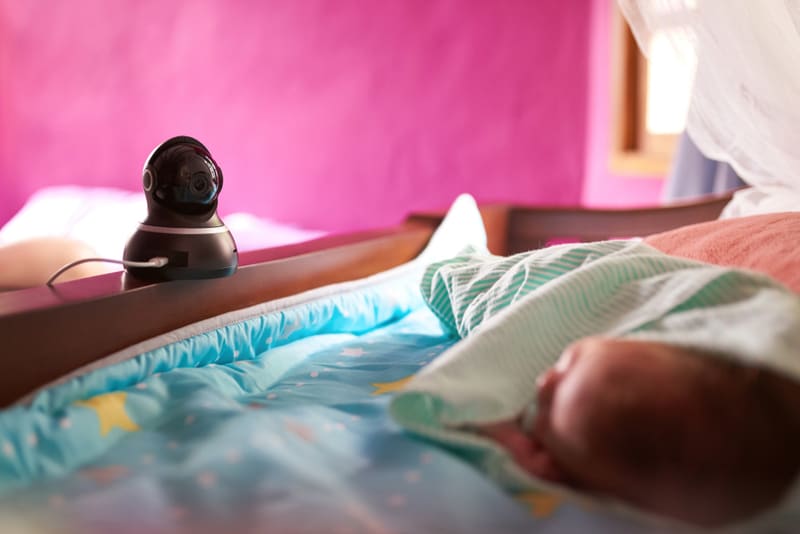
Smart baby monitors may be a huge investment for moms on a budget and parents who prefer to save a few bucks. However, these gadgets are true lifesavers.
All those nights when I jumped up to check on my baby’s breathing or worried that he had been lying in bed awake and hungry for hours while I slept, gave me anxiety attacks!
I’m sure I’m not the only one, but that’s exactly why video baby monitors are so handy.
Created by parents who were disappointed with existing baby monitors, both Nanit and Miku are world-class products for ensuring the safety of every baby.
Based on the in-depth review of both Wifi baby monitors and the comparison between the two, the winner of the Nanit vs Miku battle is the Nanit Plus.
Miku is a great video baby monitor and does have a lot of positives, especially when it comes to the security feature, which involves military-grade security level.
However, Nanit Plus has held the title of a best-selling video monitor for two years.
You can compare Nanit vs Miku on your own, as they do have a lot of similar characteristics, which was evident from the in-depth reviews of both products.
Also, both of these devices are FSA/HSA approved on Amazon and the official Miku and Nanit websites.
Finally, I encourage you to make a decision based on your personal preferences and needs, as what works for me might not work for you. Happy shopping!
Like this post? Please share or pin it for later. You can also stay in the loop and follow us on Facebook, Instagram or Pinterest.
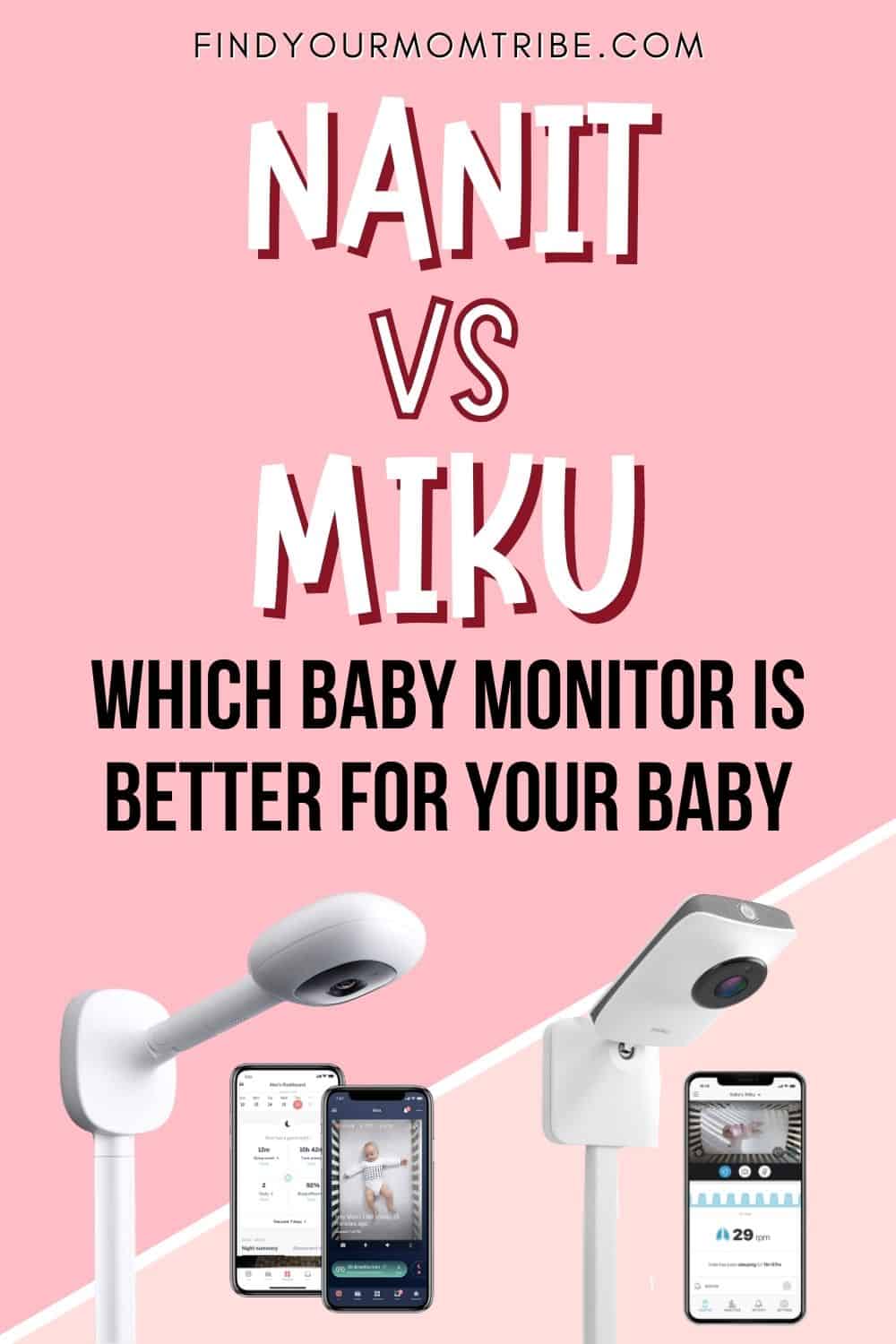
We love honesty! Find Your Mom Tribe is an Amazon Associate and we earn from qualifying purchases through affiliate links at no extra cost to you. Please see our full Amazon Affiliate disclosure for more information.

